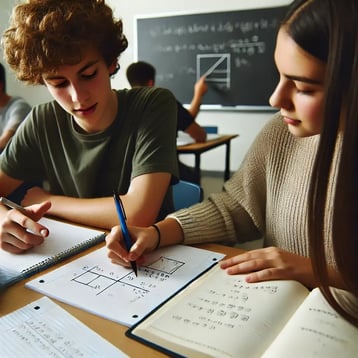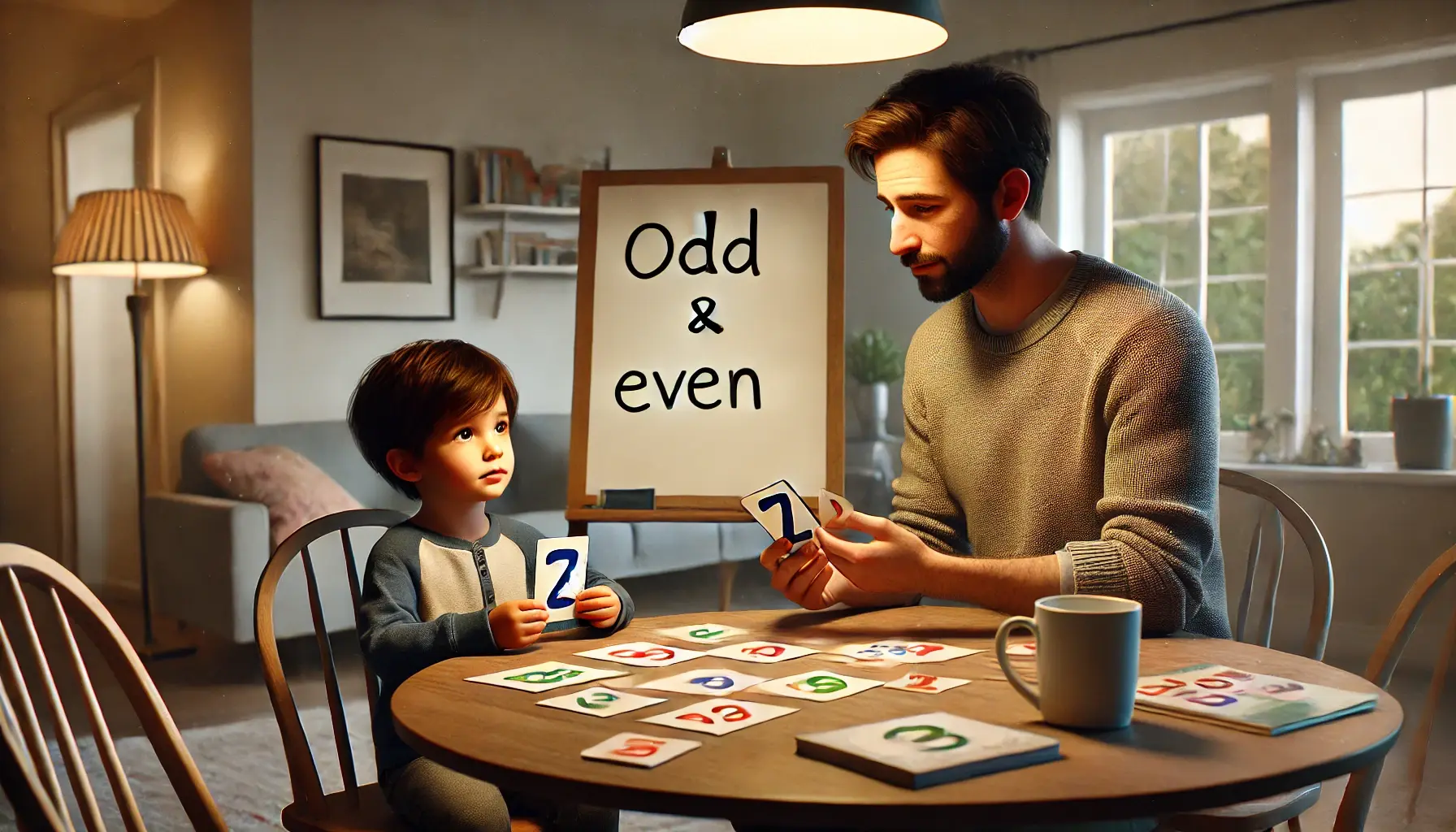
In 8th grade, students already understand basic math well; now it's time to take things further. This year, they start learning new and more challenging topics that prepare them for high school. Algebra becomes a key focus, where they begin solving equations, working with variables, and understanding functions. Geometry also plays a big role as students explore shapes, angles, and the properties of space. Along the way, they’ll practice problem-solving skills and discover how math applies to real-world situations, helping them feel more confident as they move into the next phase of their education. It’s a year of exciting growth and preparation for what’s ahead in high school math.
In this article, we'll walk you through what 8th graders will learn in math, giving you a clear idea of what to expect and how to help them stay ahead.
10 Core Skills and Topics Students Will Learn in 8th-Grade Math
1. Slope
In 8th grade, students will focus on understanding the concept of slope, which shows how steep a line is. They will learn that slope is the ratio of the vertical change (how much a line moves up or down) to the horizontal change (how far it moves left or right) between two points on a graph.
They'll practice finding the slope using these points and interpreting graphs to identify the slope. Additionally, students will explore how to determine if two lines are parallel or perpendicular by working with equations and graphing. This will help them prepare for more advanced algebra and geometry topics.
2. Linear Equations
In 8th grade, students will also learn how to graph linear equations. They’ll start by plotting points and using a table to create a graph. Eventually, they'll be able to graph a line just by knowing the slope and y-intercept. After practicing how to graph, students will move on to solving linear equations by converting them into slope-intercept form, which is written as y = mx + b. They’ll also learn about another way to write linear equations, called point-slope form, which uses a different formula. This step-by-step approach helps students understand how linear equations work and how to use them.
3. Linear Systems

In 8th grade, students will begin exploring linear systems, which involve working simultaneously with two or more linear equations. The goal is to find a solution that satisfies all the equations in the system, usually by finding the point where the lines intersect on a graph. Students will first learn how to solve linear systems by graphing each equation on a coordinate plane and identifying the point of intersection.
Once they’ve mastered this, they'll move on to two important methods: substitution and elimination. In substitution, students replace one variable with an expression from another equation, allowing them to solve the system step by step. With elimination, they add or subtract the equations to eliminate one of the variables, making solving the remaining one easier. These techniques help solve problems faster and lay the groundwork for more advanced algebra topics.
4. Linear Inequalities
In 8th grade, students will be introduced to linear inequalities, similar to linear equations, but use inequality symbols like >, <, ≥, and ≤ instead of equal signs. They'll learn to represent these inequalities by graphing them on a coordinate plane. This involves shading one side of the line to show where the solutions lie.
Students will also explore how to solve systems of linear inequalities by graphing both inequalities and finding the overlapping shaded areas where the solutions to both inequalities exist. Additionally, they'll practice solving systems of linear inequalities using methods like substitution and elimination, just like with linear equations. These skills help students understand inequalities and prepare them for more advanced math topics.
5. Scatter Plots
In 8th grade, students will be introduced to scatter plots showing the relationship between two data sets. They will learn to create scatter plots by plotting points from a given data table on a graph. Additionally, students will practice describing the patterns or relationships they observe in these plots, such as whether the data shows a positive, negative, or no correlation. By working with scatter plots, they'll better understand how to analyze and interpret real-world data in a visual format.
6. Functions

In 8th grade, students will start learning about functions, which show how one value (the input) relates to another (the output). They'll use tables to understand how functions work, seeing how each input leads to a specific output.
By the end of their lessons, students will be able to write their functions based on a table of values and evaluate graphs to decide whether or not they represent a function. Additionally, they’ll learn to identify a function's domain (all possible inputs) and range (all possible outputs) by looking at a graph, building a strong foundation for future math concepts.
7. Exponents
In 8th grade, exponents become a key focus as students build on their previous knowledge. They'll learn how to rewrite multiplication and division using a base and exponent, making it easier to handle large numbers and simplify expressions. For example, instead of writing out 5 x 5 x 5, students will understand how to express it as 5³.
This is also the time when students are introduced to negative exponents. They'll learn that negative exponents represent the reciprocal of the base raised to a positive power. For instance, 3⁻² would be rewritten as 1/3².
Additionally, students will explore the laws of exponents, which cover how to add, subtract, multiply, and divide exponents. They'll also learn about square roots and cube roots, which involve finding the number that, when multiplied by itself (or by itself three times for cube roots), equals the original number.
8. Radicals
In 8th grade, students will also be introduced to radicals, learning to work with square and cube roots. They'll explore the laws of radicals, which help them simplify and evaluate radical expressions. Additionally, students will practice rewriting radicals in exponent form, making solving certain types of problems easier. By working with both radicals and exponents, students will be better prepared to solve more complex equations involving variables in the future. This knowledge sets them up for success as they move into higher-level math.
9. Exponential and Radical Equations

In 8th grade, students will tackle exponential and radical equations that include variables, learning key strategies to solve them step by step. For exponential equations, students will practice solving problems where variables appear in the exponent, such as 2^x = 16, by learning techniques like rewriting the equation to have the same base or using logarithms in future courses.
For radical equations, they will learn how to isolate the radical expression (like a square root or cube root) and then square or cube both sides of the equation to eliminate the radical, making it easier to solve for the variable. For example, in an √x + 3 = 7 equation, students will learn to subtract 3 from both sides and then square both sides to solve for x.
10. Pythagorean Theorem
In 8th grade, students will be introduced to the Pythagorean Theorem, which states that a² + b² = c². They'll begin by working with right triangles, using the theorem to find the missing length of one side when the other two sides are known. Once they’re comfortable with this process, students will apply the Pythagorean Theorem to solve real-world word problems, such as determining distances between points. This step-by-step practice helps them understand how the theorem can be used beyond simple triangle problems, giving them a valuable tool for geometry and everyday problem-solving.
Improve Your 8th Grader’s Math Skills with Genie Academy
Genie Academy, a trusted tutoring center in New Jersey, is dedicated to helping students excel in all core subjects, including math, abacus, writing, reading, and coding, across all grade levels. For 8th graders, math can be challenging as it introduces more advanced concepts like algebra, geometry, and linear equations. At Genie Academy, students receive focused 8th-grade math tutoring designed to strengthen their understanding of these key concepts, ensuring they are well-prepared for high school.
Whether your child needs help grasping specific topics or wants to improve overall performance, Genie Academy offers online and offline tutoring options. With small class sizes, your child will benefit from personalized attention, tailored lessons, and a supportive learning environment that fosters confidence and growth. Give your 8th grader the tools to succeed in math with Genie Academy’s expert tutoring services.
We have locations in East Brunswick, Hillsborough, Marlboro, South Brunswick, Plainsboro, and South Plainfield, New Jersey.
Explore more about us, our success stories, our core values, our philosophy, and our interesting history. You can also discover our reviews and testimonials and learn about the true benefits of Genie Academy.
Math Skills Checklist for the End of 8th Grade
By the end of 8th grade, students will have developed strong math skills that prepare them for high school math. Here's what they should be able to do:
- Understanding Slope:
Calculate the slope using two points or a graph and identify parallel or perpendicular lines by comparing slopes. - Graphing Linear Equations:
Graph linear equations using a table, points, or the slope and y-intercept. Convert equations into slope-intercept form for graphing. - Solving Systems of Equations:
Solve systems of linear equations using graphing, substitution, and elimination methods. Understand the point of intersection as the solution. - Working with Linear Inequalities:
Graph linear inequalities and solve systems of inequalities by finding the overlapping solution area. - Analyzing Scatter Plots:
Create scatter plots from data and describe relationships between variables, identifying correlations. - Understanding Functions:
By examining a graph, write functions from tables and determine if a relation is a function. Identify the domain and range of a function. - Working with Exponents:
Simplify expressions with exponents, apply the laws of exponents, and evaluate square roots and cube roots. - Solving Exponential and Radical Equations:
Solve exponential and radical equations and simplify them by combining like terms. - Applying the Pythagorean Theorem:
Use the Pythagorean Theorem to find missing side lengths of right triangles and solve real-world geometry-related problems.
Conclusion
By the end of 8th grade, students will have a solid understanding of key math concepts, from solving equations and working with exponents to applying the Pythagorean Theorem and analyzing functions. These skills prepare them for high school math and provide a foundation for everyday problem-solving. With these abilities, they’ll be ready to tackle more advanced challenges in the years ahead.





